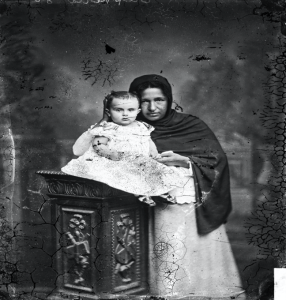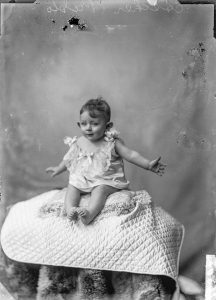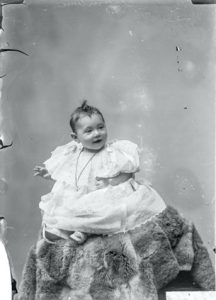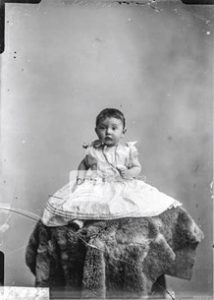SITE IN SPANISH
By Andrea Aramburú Villavisencio
In a couple of weeks, I will be back in Lima, my hometown, to do some fieldwork for the project Affective and Immaterial Labour in Latin(x) American Culture, led by Dr Rachel Randall. The main core of my field research will revolve around the Courret Archive at the Biblioteca Nacional del Perú’s digital library, which houses a series of photographs taken by Eugenio Courret and his successor after he left for France, Adolphe Dubreuil, in Lima, during the second half of the 19th century. Within the archive, I will be specifically thinking about a sub-series of images, those picturing, and – as I will soon explain – often also hiding, wet nurses.
Wet nursing was a common practice in colonial and newly independent Peru, particularly among the upper classes. Before the abolition of slavery in 1854, it was not unusual for Afro-Peruvian women to do both unpaid and paid work as wet nurses for criollo (European-descendant/upper-class) families. The practice of hiring wet nurses carried on into the early 20th century, even if the discourses surrounding it were very contradictory. Most of the women working as wet nurses were black or mulatas (mixed-race), and generally poor (Rosas 2004: 106). Some newspapers used their racial and class difference to construct negative views of wet nursing, basing their arguments upon hygienist discourses. Some periodicals, such as the Semanario Crítico directed by Olavarrieta, discouraged the hiring of wet nurses, in order to safeguard the image of (white) women as devoted mothers who would breastfeed and take care of their own children. Other periodicals, such as the Diario de Lima encouraged it, advertising the availability of wet nurses on their pages, most likely because the practice remained popular among elite families, who continued to hire them in spite of what hygienists had to say (Rosas 2005).

The amas or nodrizas (wet nurses) pictured by Courret are mostly black women. Many are dressed in costumes covering their bodies and part of their faces. As the researcher Carlos Estela-Vilela has said, these women appear similar to the famous tapadas limeñas (women who wore clothes covering their entire bodies). Their attire included the saya y manto (particular kinds of skirt and veil). The tapadas popularised a habit of promenading the streets in anonymity, veiling their faces, leaving only one eye visible to the public. But if the tapadas had some sort of agency over their bodies, in terms of what was shown and what wasn’t, the wet nurses pictured here have none. The photographs inscribe the symbolic ownership of the children, or the “pequeños amos” (little masters) (Estela-Vilela 2021), over the wet nurses’ presence and visibility.
Amas de leche
In Image Matters, Tina Campt writes on the historical power of vernacular photography in US black communities. Campt thinks about a series of archives made of family portraits and everyday pictures, via a range of sensory regimes from the haptic to the auditive. In doing so, she asks about the “social life” of these images. She uses this expression to refer to “the social, cultural, and historical relationships figured in the image, as well as a larger set of relationships outside and beyond the frame” (Campt 2012: 6).
What is the social life of the photographs of wet-nurses housed in the Courret Archive? Can we even access their historicity? These are pictures labelled with a family name and some extra information. Like Figure 1, the name is always that of the baby and never that of the nurse. When mentioned, such as in the photograph shown below, it is only through the generic term “ama”. Both the portraits and their titles imply who can be admitted within this visual regime, and who ought to be made invisible, always already forgotten.

Lactantes
There is a further set of pictures in the Courret Archive where loss and violence become even more poignant. I came across these photographs, categorised using the label “lactantes” (nursing babies), by exploring the keywords used to archive the amas de leche (wet nurse) pictures. The “lactantes” set shows portraits of very young babies sitting by themselves. They are called “lactantes”, I assume, because they must be of a breastfeeding age. These babies, most likely, have a dedicated wet nurse to take care of their nourishment and needs. And yet, the portraits show them as self-sufficient, sitting by themselves, fully owning their subjective presence.

The first time I saw these photographs, I felt there was something very odd, if not uncanny, about them. I was confused, in particular, by the photograph titled “Ascher, Pablo y ama” (Ascher, Paul and wet nurse; Figure 3), one of the first ones I stumbled upon. The image didn’t seem to be of the ama, and yet the title included a reference to her. While this seemed very odd, I didn’t think too much about it then. It was only after reading the article “The Dark Side of Photography: Techno-Aesthetics, Bodies, and the Residues of Coloniality in Nineteenth-Century Latin America” by Beatriz González-Stephan and Carl Good that I returned to the Courret Archive with a different gaze.
In this piece, the authors look at four cartes de visite from the 19th century, paying special attention to a couple of pictures from Venezuela that feature babies firmly positioned over what, in their words, seems to be “a mere lump” (2016: 32). Later on, we find out that this “lump” is actually the covered nanny holding the baby in place. The authors propose that we think about how we construct the “gaze” when we look at these cartes de visite, in the context of their historical formations. They suggest that there are elements in the photographs which escape our gaze but at the same time emerge as points of reading “against the grain” of official history. In the Venezuelan photos, the “hidden” detail are the nannies, who may allow the whole archive to be read “in its reverse” (35).
Family matters
Everyone I talk to has something to say about wet nurses in Lima, or so it seems. When I chat with my mother over the phone, she mentions that my great-aunt, now almost 100 years old, and possibly two of her siblings (who have already passed away), all had wet nurses. “Who were these women?” – I ask her – “Do you think she remembers, at least, their names?” A few days later, having a chat with my sister, I tell her a bit about the project. She mentions that my dad, born in 1954, was breastfed by a wet nurse. I consider the possibility of this being true, even if my sister often exaggerates the facts that make up her stories. According to her, my paternal grandmother, La Nana, who was born in Lima to a wealthy Italian family, never had milk.

With these ideas in mind, and aware that this would have happened long after the time of Courret, I rush once again to the digital archive, and I type in my paternal family name. I find two pictures of “bebés de la familia Aramburú” (babies from the Aramburú family) archived under the keyword “lactantes”.
Up to the moment when I’m writing these reflections, my encounter with the photographs of wet nurses in the Courret Archive has been entirely virtual. As I scroll through the BNP website, I try to imagine what would be added to the experience when/if I do get to see these photos in person. Some photographs have illegible scribbles on the top corner, that get lost in their graininess. Many of them have been recomposed via a process of restoration, and the digital version still shows the visible scars of their wear and tear. The digital, however, adds to the photos a further layer of displacement, which I find curious to say the least. I’m in Bristol, sat at a café, and my gaze lingers on the first photograph of the two Aramburú babies, possibly my very far removed relatives.
Suddenly, it’s the 19th century. It could have been summer or winter (we only really feel two seasons in Lima). The day seems special, maybe the days surrounding the baby’s Christening, a big family event in Catholic Lima. The Aramburú family takes a trip to Fotografía Central, the studio managed by Courret, located in Calle Mercaderes. The baby wears a fancy white dress, with white shoes, and a chain around their neck, most likely their Christening medallion, made-to-order in one of Lima’s jewellers by the child’s godparents. The baby has an attentive facial gesture, as if someone was telling them “look over here, dear, over here”, trying to hold their gaze and attention while Eugenio Courret takes the picture. Placed at the centre of the frame, sat on what seems to be a covered stool, the baby smiles and wiggles one of their hands in the air, and holds onto the dress with the other one.

I drink a sip of my coffee and reassess my gaze. There seems to be something strange about the baby’s position on the stool — it seems that they could easily slide away, particularly when we remember that taking a portrait in the time of the Courret was no point-and-shoot — it took approximately half an hour, if not longer. Is there a wet nurse holding the baby in place, hiding behind the covered stool? It’s hard to know for sure, but the structural conditions seem to make it very plausible.
In this image, family relations are portrayed as within and beyond the frame. The social life of the photograph is as much that of the baby’s Christening as it is that which is violently hidden, for instance, the fact that most of the baby’s reproductive upbringing is done by a nanny — someone who is both within and beyond the family, within and beyond the frame.
The nurse does not count as a subject within this visual regime. Her absence enables the “individuality” and “self-sufficiency” of the baby — carrier of the nation’s futurity — to be emphasised. I end these reflections by quoting, once again, Campt, who poses some valuable questions about the matter of some images, and why it is crucial to interrogate what’s the matter with them:
“What happens when we linger on such images? What do they reveal and what do they simultaneously conceal in the very moment of revelation? What invisible forms of labor—domestic labor, semiotic labor, affective labor—do they make visible as practices of diasporic formation? And what are the technologies of vision, the politics of reading, and the sensual practices of archival creation, collection, and circulation that render this labor visible?” (Campt 2012: 41)
Andrea Aramburú Villavisencio (Lima, 1989) is Research Associate on the project Affective and Immaterial Labour in Latin(x) American Culture. She holds a PhD in Latin American Studies from the University of Cambridge, an MA in Contemporary Literature, Culture and Theory from King’s College London and a BA in Hispanic Literature from the Pontificia Universidad Católica del Perú. Her research explores Latin American visual culture, including comics, photography and artists books through queer theory and decolonial feminisms.

Extremely interesting article. I had never thought about this subject while studying the global care chains currently developing between the Global North and the Global South. Gracias!
Very interesting. I first skim-read the article focusing more on the pictures and the suspicion that there might be someone invisible/y holding the babies came to my mind straight away. Those babies look too young to be so stable considering the instability of the seats and the time it must have taken to photograph them. I find the rationale of women not having milk an interesting one. Was this really the concern or was it more related to time or to fears about breastfeeding and the aesthetics of female bodies?
This is the right web site for anybody who hopes to understand this topic.
You know so much its almost hard to argue with you (not that I really would want to…HaHa).
You certainly put a brand new spin on a topic that’s been written about for years.
Excellent stuff, just great!